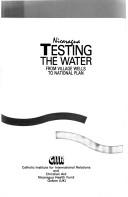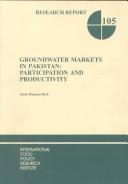| Listing 1 - 10 of 13 | << page >> |
Sort by
|

ISBN: 1852870354 Year: 1989 Publisher: London Catholic Institute for International Relations (CIIR)
Abstract | Keywords | Export | Availability | Bookmark
 Loading...
Loading...Choose an application
- Reference Manager
- EndNote
- RefWorks (Direct export to RefWorks)
Water-supply, Rural --- Social aspects --- Rural water-supply --- Sanitation, Rural
Book
ISBN: 0128041382 0128041323 9780128041383 9780128041321 Year: 2016 Publisher: Amsterdam, [Netherlands] : Elsevier,
Abstract | Keywords | Export | Availability | Bookmark
 Loading...
Loading...Choose an application
- Reference Manager
- EndNote
- RefWorks (Direct export to RefWorks)
Water-supply, Rural. --- Rural water-supply --- Sanitation, Rural
Book
ISBN: 178040722X 1780407211 Year: 2015 Publisher: London, England : IWA Publishing,
Abstract | Keywords | Export | Availability | Bookmark
 Loading...
Loading...Choose an application
- Reference Manager
- EndNote
- RefWorks (Direct export to RefWorks)
This manual and the free downloadable costing tool is the outcome of a project identified by the Water, Sanitation and Health Programme (WSH) of the World Health Organization (WHO) faced with the challenge of costing options for improved access, both to safe drinking water and to adequate sanitation. Although limited in scope to the process of costing safe water supply technologies, a proper use of this material lies within a larger setting considering the cultural, environmental, institutional, political and social conditions that should be used by policy decision makers in developing countries to promote sustainable development strategies. Costing Improved Water Supply Systems for Low-income Communities provides practical guidance to facilitate and standardize the implementation of social life-cycle costing to "improved" drinking-water supply technologies. These technologies have been defined by the WHO/UNICEF Joint Monitoring Programme for Water Supply and Sanitation, as those that, by the nature of its construction, adequately protect the source of water from outside contamination, in particular with faecal matter. The conceptual framework used has also been conceived to be applied to costing improved sanitation options. To facilitate the application of the costing method to actual projects, a basic tool was developed using Microsoft Excel, which is called a water supply costing processor. It enables a user-friendly implementation of all the tasks involved in a social life-cycle costing process and provides both the detailed and the consolidated cost figures that are needed by decision-makers. The scope and the limits of the costing method in a real setting was assessed through field tests designed and performed by local practitioners in selected countries. These tests were carried out in Peru and in six countries in the WHO regions of South-East Asia and the Western Pacific. They identified practical issues in using the manual and the water supply costing processor and provided practical recommendations.
Water-supply, Rural. --- Rural water-supply --- Sanitation, Rural
Book
Year: 2003
Abstract | Keywords | Export | Availability | Bookmark
 Loading...
Loading...Choose an application
- Reference Manager
- EndNote
- RefWorks (Direct export to RefWorks)
Water resources development --- Water-supply, Rural --- Law and legislation --- Finance --- United States. --- Mni Wiconi Rural Water Supply Project (U.S.). --- Water-supply --- Water-supply, rural --- Nature --- Technology & engineering
Book
Year: 2013 Publisher: [Washington, D.C.] : [U.S. Government Printing Office],
Abstract | Keywords | Export | Availability | Bookmark
 Loading...
Loading...Choose an application
- Reference Manager
- EndNote
- RefWorks (Direct export to RefWorks)
Water-supply, Rural --- Water resources development --- Finance. --- Finance --- Law and legislation --- Mni Wiconi Rural Water Supply Project (U.S.) --- Appropriations and expenditures.
Book
ISBN: 0821308505 9780821308509 Year: 1987 Publisher: Washington, D.C.: World Bank,
Abstract | Keywords | Export | Availability | Bookmark
 Loading...
Loading...Choose an application
- Reference Manager
- EndNote
- RefWorks (Direct export to RefWorks)
Communauté rurale --- Rural communities --- Pays en développement --- Developing countries --- Approvisionnement en eau --- water supply --- Pompe --- Pumps --- Propriété technologique --- technical properties --- Efficacité --- Efficiency --- Hand pumps --- Water-supply, Rural --- Rural water-supply --- Sanitation, Rural --- Hand-operated pumps --- Handpumps --- Pumps, Hand --- Pumping machinery --- Testing
Book
ISBN: 0946688222 9780946688227 Year: 1986 Publisher: [London, UK] : Intermediate Technology Publications,
Abstract | Keywords | Export | Availability | Bookmark
 Loading...
Loading...Choose an application
- Reference Manager
- EndNote
- RefWorks (Direct export to RefWorks)
Water harvesting --- Water-supply, Rural. --- Rural water-supply --- Sanitation, Rural --- Harvesting, Water --- Precipitation trapping --- Rainwater catchment --- Rainwater harvesting --- Runoff collection --- Water conservation --- Water-supply --- Rainwater --- Runoff irrigation --- Water harvesting. --- Runoff. --- Irrigration --- Écoulement (Hydrologie) --- Tailwater recovery systems. --- Water-supply, Rural --- Water harvesting - Developing countries --- Écoulement (Hydrologie)
Book
ISBN: 0821306480 Year: 1984 Publisher: Washington, D.C.
Abstract | Keywords | Export | Availability | Bookmark
 Loading...
Loading...Choose an application
- Reference Manager
- EndNote
- RefWorks (Direct export to RefWorks)
S10/0520 --- Hand pumps --- -Water-supply, Rural --- -International Drinking Water Supply and Sanitation Decade, 1981-1990 --- Drinking water --- Sanitation --- Special decades --- Water-supply --- Rural water-supply --- Sanitation, Rural --- Hand-operated pumps --- Handpumps --- Pumps, Hand --- Pumping machinery --- China: Economics, industry and commerce--Industry: since 1949 --- Congresses --- International cooperation --- Conferences - Meetings --- Zonder onderwerpscode

ISBN: 0896291081 Year: 1996 Publisher: Washington : International Food Policy Research Institute,
Abstract | Keywords | Export | Availability | Bookmark
 Loading...
Loading...Choose an application
- Reference Manager
- EndNote
- RefWorks (Direct export to RefWorks)
Ressource en eau --- Water resources --- Eau souterraine --- groundwater --- Eau d'irrigation --- Irrigation water --- Réseau d'irrigation --- irrigation systems --- Méthode d'irrigation --- irrigation methods --- Matériel d'irrigation --- Irrigation equipment --- Utilisation de l'eau --- Water use --- Conservation de l'eau --- Water conservation --- Prise de décision --- Decision making --- Participation sociale --- Social participation --- Politique de la recherche --- Research policies --- Pakistan --- Groundwater --- -Irrigation water --- -Water-supply, Rural --- -Wells --- -Tube wells --- Water wells --- Hydraulic structures --- Well water --- Rural water-supply --- Sanitation, Rural --- Water --- Ground water --- Subterranean water --- Underground water --- Water, Underground --- Hydrogeology --- Economic aspects --- -Economic aspects --- -Groundwater --- Water-supply, Rural --- Wells --- Tube wells
Book
ISBN: 3039213385 3039213377 Year: 2019 Publisher: MDPI - Multidisciplinary Digital Publishing Institute
Abstract | Keywords | Export | Availability | Bookmark
 Loading...
Loading...Choose an application
- Reference Manager
- EndNote
- RefWorks (Direct export to RefWorks)
In current times, highly complex and urgent policy problems—e.g., climate change, rapid urbanization, equitable access to key services, land rights, and massive human resettlement—challenge citizens, NGOs, private corporations, and governments at all levels. These policy problems, often called ‘wicked’, involve multiple causal factors, anticipated and unanticipated effects, as well as high levels of disagreement among stakeholders about the nature of the problem and the appropriateness of solutions. Given the wickedness of such policy problems, interdisciplinary and longitudinal research is required, integrating and harnessing the diverse skills and knowledge of urban planners, anthropologists, geographers, geo-information scientists, economists, and others. This Special Issue promotes innovative concepts, methods, and tools, as well as the role of geo-information, to help (1) analyze alternative policy solutions, (2) facilitate stakeholder dialogue, and (3) explore possibilities for tackling wicked problems related to climate change, rapid urbanization, equitable access to key services (such as water and health), land rights, and human resettlements in high-, middle-, and low-income countries in the North and South. Such integrative approaches can deepen our understanding of how different levels of government and governance reach consensus, despite diverging beliefs and preferences. Due to the particularly complex spatiotemporal characteristics of wicked policy problems, innovative concepts, alternative methods, and new geo-information tools play a significant role.
spatial data infrastructures --- n/a --- water point mapping --- complex adaptive systems --- FCM (Fuzzy Cognitive Mapping) --- spatial data infrastructure (SDI) --- Danube region --- longitudinal analysis --- geospatial data --- administrative technologies --- data gaps --- SDI development --- functionality --- key services --- interactive mapping tools --- the Netherlands --- coordination --- New York City --- renewable energy --- energy governance --- social acceptance --- large-scale base map --- Citizen Science --- self-organisation --- European Union Strategy for the Danube Region --- dashboard --- climate change --- Flanders --- information communication technologies (ICTs) --- heat wave --- Tanzania --- vulnerability --- rural water supply --- ICT4D --- income groups --- water points --- e-services --- information infrastructure --- Belgium --- mobile phone --- maptable --- climate governance --- governance --- rural water governance
| Listing 1 - 10 of 13 | << page >> |
Sort by
|

 Search
Search Feedback
Feedback About UniCat
About UniCat  Help
Help News
News